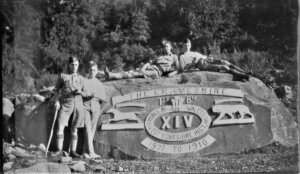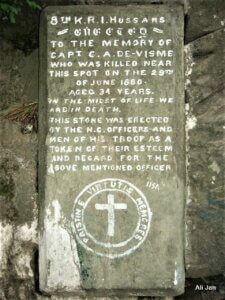Carved in Stone – the Murree Hills Military Memorials
Established in 1853 by the British seeking refuge from the sweltering heat of the plains, the hill station of Murree evolved into both a sanatorium resort and the summer headquarters of the Army’s Northern Command. Over time, the hills became studded with monuments, memorials and markers commemorating fallen comrades, including 16 British-era cemeteries in and around Murree.
This abridged version of an article by Dr Ali Jan, a ‘tourism expert with a passion for promoting military history tourism in Pakistan’ (published in Bugle and Trumpet, the magazine of Pakistan’s Army Institute for Military History, No. 2/2024), investigates three memorials carved by soldiers and officers of the British Raj in the picturesque landscape of the Murree Hills.
West Yorkshire Regiment Monument, Kuldana
‘Kuldana, now the Army School of Logistics (ASL) and one of the oldest cantonments near Murree garrison, housed various British regiments. Remnants of this military past – old barracks, cemeteries and a chapel still stand today.

Kuldana (Source: Ali Jan)
Hiking in Kuldana’s secluded woods, I stumbled upon a stone monument commemorating the Prince of Wales’s Own West Yorkshire Regiment, stationed here from 1907 to 1910. On sharing this discovery online, I received a 1945 photograph from Jesse Bridge, a British Army veteran who recalled the memorial from his 1940s service in Murree.
The large rock monument has a military crest and inscription of the ‘Prince of Wales’s Own (XIV) West Yorkshire Regt’ dated ‘1907 to 1910’. The regimental insignia, the ‘Nec Aspera Terrent’ [‘Difficulties be damned’] motto with an image of a horse, and ‘1807-1831 India’, with an image of a tiger, are visible. The battalion’s name ‘1st Bn’ is now almost illegible. Above it there is a faded inscription ‘THE KNAVES MIRE’; below it ‘XIV’ is inscribed in the centre.
Unaware of the monument’s existence, the Yorkshire Regiment Museum confirmed that the West Yorkshires had been in the Murree area from 1907-1911: ‘Our records state that the 1st Bn West Yorkshire Regiment moved from Lahore to Rawalpindi in 1907 and remained in the (Murree) area until it returned to England in 1911. We were not aware of it and cannot be sure what the memorial stone in Murree commemorates’.
The museum also emailed the battalion’s Service Digest dated 1907-1911, detailing its general activities in Murree Hills. According to its history, the 1st Battalion (XIV) West Yorkshire Regiment was originally raised in 1685; royal permission to wear the White Horse of Hanover on its crest was granted in 1759; the badge of the Royal Tiger superscribed with ‘India’ was granted after service in India from 1807 to 1831. In 1876 the Prince of Wales (later King Edward VII) presented new colours to the 1st Battalion, and conferred on the regiment the title ‘The Prince of Wales’s Own’. Then in 1881 the 14th was honoured and named ‘The West Yorkshire Regiment’.
In 1958, the West Yorkshire Regiment (The Prince of Wales’s Own) was amalgamated with the East Yorkshire Regiment (The Duke of York’s Own) to form the Prince of Wales’s Own Regiment of Yorkshire, whose regimental headquarters and museum are located at York, in the UK.
De Visme Memorial, Lower Jhika Gal Road

A roadside memorial on the Lower Jhika Gali Road (formerly Lower Forest Road) that connects Jhika Gali with the Mall marks the spot where Captain Gerard Auriol de Visme of 8th King’s Royal Irish Hussars died, after being hit in an unusual accident – when a hilltop stone was dislodged by a goat.
The inscription reads:
‘8th K.R.I. Hussars
Erected to the memory of Capt G.A. de Visme, who was killed near this spot on the 29th of June 1880, aged 34 years.
In the midst of life, we are in death.
This stone was erected by the N.C. Officers and Men of his troop as a token of their esteem and regard for the above-mentioned officer.
Pristinae Virtutis Memores [‘Mindful of former valour’].
Reports in the Illustrated London News and the Morning Advertiser described how de Visme, a Captain in the 8th Hussars, the only son of Edward de Visme, Esq., of New Court, Gloucestershire, had married Geraldine Mary Kyrle (daughter of Major-Gen Ernle Kyrle R.H.A) in July 1878, shortly after being promoted from Lieutenant and Adjutant – a popular promotion, as ‘his brother officers and superiors recognised in him a smart, intelligent and industrious adjutant’. He had arrived in British India in 1879 to take part in the 2nd Anglo-Afghan War, for which he received the Afghanistan War Medal.
De Visme survived ‘only two hours’ after being hit by the dislodged stone, and was buried with military honours.
Northumberland Fusiliers Monument, Lower Topa
Once, while driving through Lower Topa, I stopped at a kiosk for tea. An old villager mentioned a weathered rock called Samp ki Tarrar in the forest. In the local dialect, Samp means serpent, and Tarrar is rock.

Legend has it that a giant serpent once terrorised Murree, crushing everything in its path. After many years, a mysterious horseman appeared and killed the serpent, saving the townspeople.
Intrigued, and helped by a guide, I set out to find the rock. After walking half a mile down the road to Kohala, we veered off and climbed uphill through thick foliage. There, I found a large, moss-covered boulder about 11’ wide x 7’ long. On it was a faded carving of a horseman, slaying a dragon under his horse’s hooves.
As I cleared away the moss and debris, I remembered my childhood reading of the tale of St. George and the Dragon. According to legend St. George, the patron saint of England, slayed a dragon terrorising the inhabitants of Silene, Libya, with its insatiable appetite for sheep and children – on condition that the townsfolk agreed to convert to Christianity.
Images of the legend are often used as English emblems and badges. It is not uncommon to spot British-era military crests carved on the wayside in many parts of Pakistan. Finding such an insignia on a rock in Murree suggested a British-era military connection. The weathered carving included indecipherable Latin letters and a prominent ‘V’.
An internet search led me to the Northumberland Fusiliers (NF), a regiment known in the 19th century as the ‘Fighting Fifth’, which explained the Roman numeral ‘V’. Mrs Lesley Frater, curator of their regimental museum at Alnwick Castle, UK, confirmed that the carving belonged to the 1st Bn. She shared a 1909 photograph showing the once-painted carving, the motto ‘QUO FATA VOCANT’ (‘Whither the Fates call’) and the name of the sculptor ‘Pte D Bloxham’.
The 1st Battalion had left England in 1896 and returned in 1913. As documented in the 1909 St. George’s Gazette, the regimental crest had been carved by Private Bloxham. A similar carving, also made by him, exists at Cherat.
Thanks to the old man at the kiosk, I stumbled upon a fascinating relic of the British Raj. Perhaps the legend of St. George and the Dragon had been passed down through generations, blending with local folklore over time’.
Dr Ali Jan
Click here to read Dr Jan’s article in full (from Bugle and Trumpet No. 2/2024).
Thanks to military-quotes.com for the robust, contemporary translations of the first two Latin mottos.
Rachel Magowan, Editor
****************************************************************************
(Suggestions for BACSA website news items, volunteering opportunities and diary entries, are always welcome – please send them to ‘comms@bacsa.org.uk’.)
